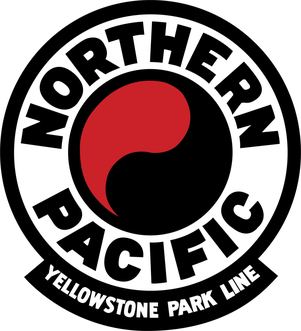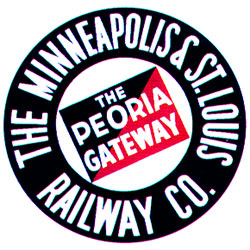Related Research Articles

James Jerome Hill was a Canadian-American railroad director. He was the chief executive officer of a family of lines headed by the Great Northern Railway, which served a substantial area of the Upper Midwest, the northern Great Plains, and Pacific Northwest. Because of the size of this region and the economic dominance exerted by the Hill lines, Hill became known during his lifetime as "The Empire Builder", and died in 1916 with a fortune of about 63 million dollars. His former home, James J. Hill House, is now a museum in Saint Paul, Minnesota.

The Great Northern Railway was an American Class I railroad. Running from Saint Paul, Minnesota, to Seattle, Washington, it was the creation of 19th-century railroad entrepreneur James J. Hill and was developed from the Saint Paul & Pacific Railroad. The Great Northern's route was the northernmost transcontinental railroad route in the U.S.

The Northern Pacific Railway was a transcontinental railroad that operated across the northern tier of the western United States, from Minnesota to the Pacific Northwest. It was approved by Congress in 1864 and given nearly 40 million acres of land grants, which it used to raise money in Europe for construction.

The Stone Arch Bridge is a former railroad bridge crossing the Mississippi River at Saint Anthony Falls in downtown Minneapolis, Minnesota. It is the only arched bridge made of stone on the entire Mississippi River. It is the second oldest bridge on the river next to Eads Bridge. The bridge was built to connect the railway system to the new Union Depot, which at that time was planned to be built between Hennepin Avenue and Nicollet Avenue. The bridge was completed in 1883, costing $650,000 at the time. 117 Portland Avenue is the general address of the historic complex.

Richard Warren Sears was an American manager, businessman and the founder of Sears, Roebuck and Company with his partner Alvah Curtis Roebuck.

The Chicago, St. Paul, Minneapolis and Omaha Railway or Omaha Road was a railroad in the U.S. states of Nebraska, Iowa, Minnesota, Wisconsin and South Dakota. It was incorporated in 1880 as a consolidation of the Chicago, St. Paul and Minneapolis Railway and the North Wisconsin Railway. The Chicago and North Western Railway (C&NW) gained control in 1882. The C&NW leased the Omaha Road in 1957 and merged the company into itself in 1972. Portions of the C. St. P. M. and O. are part of the Union Pacific Railroad network. This includes main lines from Wyeville, Wisconsin, to St. Paul, Minnesota, and St. Paul to Sioux City, Iowa.

The Minneapolis and St. Louis Railway (M&StL) was an American Class I railroad that built and operated lines radiating south and west from Minneapolis, Minnesota for 90 years from 1870 to 1960. The railway never reached St. Louis but its North Star Limited passenger train ran to that city via the Wabash Railroad.
Edwin Wheeler Winter was president of Northern Pacific Railway in 1896 then president of Brooklyn Rapid Transit Company, Brooklyn Heights Railroad and allied companies.
Robert Stetson Macfarlane was president of Northern Pacific Railway 1951–1966.

William Lafayette Darling (1856-1938), was a consulting engineer in St. Paul, Minnesota.

The Minneapolis, St. Paul and Sault Ste. Marie Railroad (MStP&SSM) was a Class I railroad subsidiary of the Canadian Pacific Railway in the Midwestern United States. Commonly known since its opening in 1884 as the Soo Line after the phonetic spelling of Sault, it was merged with several other major CP subsidiaries on January 1, 1961, to form the Soo Line Railroad.
Frederick Douglas Underwood was president of the Erie Railroad from 1901 to 1926 and a director of Wells Fargo & Company.

Charles Sumner Frost was an American architect. He is best known as the architect of Navy Pier and for designing over 100 buildings for the Chicago and North Western Railway.

Patrick Richard Heffron was an American prelate of the Catholic Church. He served as the second Bishop of Winona from 1910 until his death in 1927.

George Washington Van Dusen was from a New York family; his father, Laurence, was born in Byron Center, Genesee County, New York. Van Dusen was a grain dealer; one of many businessmen to become very rich from the milling boom in Minnesota during the second half of the 19th century.
The Electric Short Line Railway, also known as Luce Electric Lines, was a railroad that operated in Minnesota, originating in Minneapolis and heading westward. The railroad owes its nickname to the fact it was operated by members of the Luce family. The railroad ultimately reached beyond Clara City to Gluek. Today, the line has mostly been abandoned, but its former right-of-way now hosts the Luce Line State Trail operated by the Minnesota Department of Natural Resources. The Luce Line Regional Trail operated by the Three Rivers Park District connects to the state trail, but runs on roads and paths that roughly parallel what remains of the Luce Electric Lines.

Charles Elliott Perkins was an American businessman and president of the Chicago, Burlington and Quincy Railroad. He was so well respected that historian Richard Overton wrote, "From the time that Charles Elliott Perkins became vice president of the Chicago, Burlington and Quincy [1876] ... until he resigned as president in 1901, he was the Burlington."
The Montana Central Railway was a railway company which operated in the American state of Montana from 1886 to 1907. It was constructed by James Jerome Hill's St. Paul, Minneapolis & Manitoba Railway, and became part of the Great Northern Railway in 1889.

Curtis Hussey "C. H." Pettit also known as Curtis H. Pettit or C. H. Pettit was a pioneer Minneapolis banker, and a mill and elevator man. He was also involved in banking, real estate, lumber and hardware.
The Duluth, Missabe and Northern Railway (DM&N) was a railroad company in the U.S. state of Minnesota. It was one of the earliest iron ore hauling railroads of the area, said to have built the largest iron ore docks in the world, and later was one of the constituent railroads in the merger that formed the Duluth, Missabe and Iron Range Railway.
References
- ↑ New York Times, November 30, 1935, p. 15
- ↑ Mower County Transcript, Lansing, Minn., July 29, 1896
- ↑ Washington Times, July 21, 1896, p. 8
- ↑ Topeka State Journal, June 5, 1902, p. 3
- ↑ New York Sun, September 24, 1914, p. 4
- ↑ Washington Times, February 19, 1915, p. 10
- ↑ New York Tribune, February 27, 1915, p. 4
- ↑ Rock Island (Ill.) Argus, September 29, 1908, p. 4
- ↑ Lawrence A. Martin, ed., Railroads in Minnesota, Part II, April 28, 2010